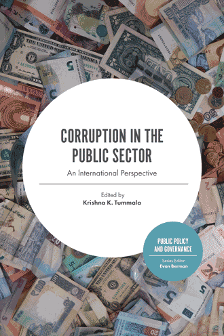Corruption in the Public Sector: An International Perspective: Volume 34

Table of contents
(12 chapters)Abstract
Singapore and Hong Kong are the least corrupt Asian countries according to their rankings and scores on Transparency International’s Corruption Perceptions Index in 2018 and other indicators. This chapter explains why these two city-states have succeeded in minimizing corruption and identifies the four best practices which might serve as lessons for policy-makers in other countries.
Abstract
Narendra Modi’s Bharatiya Janata Party made fighting corruption as a major election plank, and won the 2014 elections, and formed the National Democratic Alliance government – a majority party government in India in nearly 30 years. Modi was re-elected in May 2019 with a bigger majority. As his government celebrates the second term, it is time to assess the last five years’ accomplishments in fighting corruption. This chapter deals with the subject under four major headings. The first examines the efficacy of existing anti-corruption agencies. The second explains the office of Lokpal (Ombudsman). The third analyses the initial challenges and efforts of the Modi government. The fourth draws some conclusions.
Abstract
Right to Information (RTI) is a formidable tool in the hands of responsible citizens to fight corruption and ensure transparency and accountability within a participatory democracy. The RTI Act was promulgated in India in October 2005, and has fundamentally changed the power equation between the government and citizens. T.his chapter examines the contribution of the Act, in particular playing a significant role by providing information necessary to combat corruption in India. It is also noted, however, that RTI is not an unmixed-blessing as it is seen how costly it has been for zealous investigative journalists.
Abstract
Corruption is ubiquitous, deeply rooted in Bangladesh’s socio-political fabric. Over the past two decades, the phenomenon has reached to an extent that it is now inescapable and almost impossible to eradicate. Successive governments have tried several measures to combat corruption without much success. This chapter will probe into the nature and extent of corruption in Bangladesh from a wider perspective and consider some of the underlying historical, social, cultural, political, economic, and administrative reasons for the pervasive malfeasance in the public sector. It will evaluate the effectiveness of anti-corruption laws, and the strategies followed by institutions meant to fight corruption.
Abstract
Brazil and Chile have nearly similar recent political histories. Emerging from protracted military dictatorships at roughly the same time, both developed presidential and representative democratic processes, though with contrasting individual national emphases. Military dictatorships in both countries originated in anti-corruption rationales, among others, and both have emphasized anti-corruption practices since regime changes. Brazil impeached two presidents, ostensibly for corrupt practices. Yet, Chile has managed a corruption level, according to Transparency International’s Corruption Perception Index, that is among the lowest in Latin America, while Brazil’s is among the highest. This study compares and contrasts the two nations’ experiences with a view to uncover key causal, or at least explanatory, variables in this striking contrast in levels of perceived corruption.
Abstract
The 1994 elections had seen a near tectonic change in South Africa. The long run minority White regime was replaced by a majority Black government of the African National Congress headed by Nelson Mandela. He, along with Archbishop Desmond Tutu, did a magnificent job of avoiding a bloodbath and keeping peace between the races. A new Constitution was accepted by 1996 which subscribed to lofty ideals. Yet, they turned sour before long. Aspirations ran ahead of hard realities. Utopia seems to have morphed into dystopia. Greed, prompted by past deprivation, appears to have made opportunists of several while others became blind ideologues. In no time, the country turned to be totally corrupt. This spectacular failure of the system is explained in this chapter.
Abstract
This chapter examines the way corruption in the public procurement of goods, services, and public works has been commonplace in Southeast Asian states over many years (with the exception of Singapore), and considers the measures taken to combat such practices. It also examines why so often those efforts have not been fully effective. Three reasons are given to explain these failings. These are the following: (a) elite capture of the procurement process by influential politicians, business leaders and senior bureaucrats; (b) the informal bureaucracy in the procuring agencies which allowed corrupt practices to be followed; and (c) lack of political will to enforce measures to combat corruption
Abstract
With the increasing use of the Internet and social media, governments worldwide are adopting digital technologies and innovative strategies to communicate and engage with their citizens. Public sector agencies, especially at the local level, have been adopting emerging technologies such as the Internet of Things, artificial Intelligence, and blockchain and they are increasingly leveraging big data analytics to improve their decision-making and organizational performance. These rapid innovations pose important questions about, and concerns for, the privacy and security of the citizens accessing government information and services online. This chapter explores these issues, discusses the role of privacy policies in addressing such concerns, and highlights the need for ethical privacy policies to restore the trust and confidence of citizen users of government websites.

- DOI
- 10.1108/S2053-7697202134
- Publication date
- 2021-03-08
- Book series
- Public Policy and Governance
- Editor
- Series copyright holder
- Emerald Publishing Limited
- ISBN
- 978-1-83909-643-3
- eISBN
- 978-1-83909-642-6
- Book series ISSN
- 2053-7697